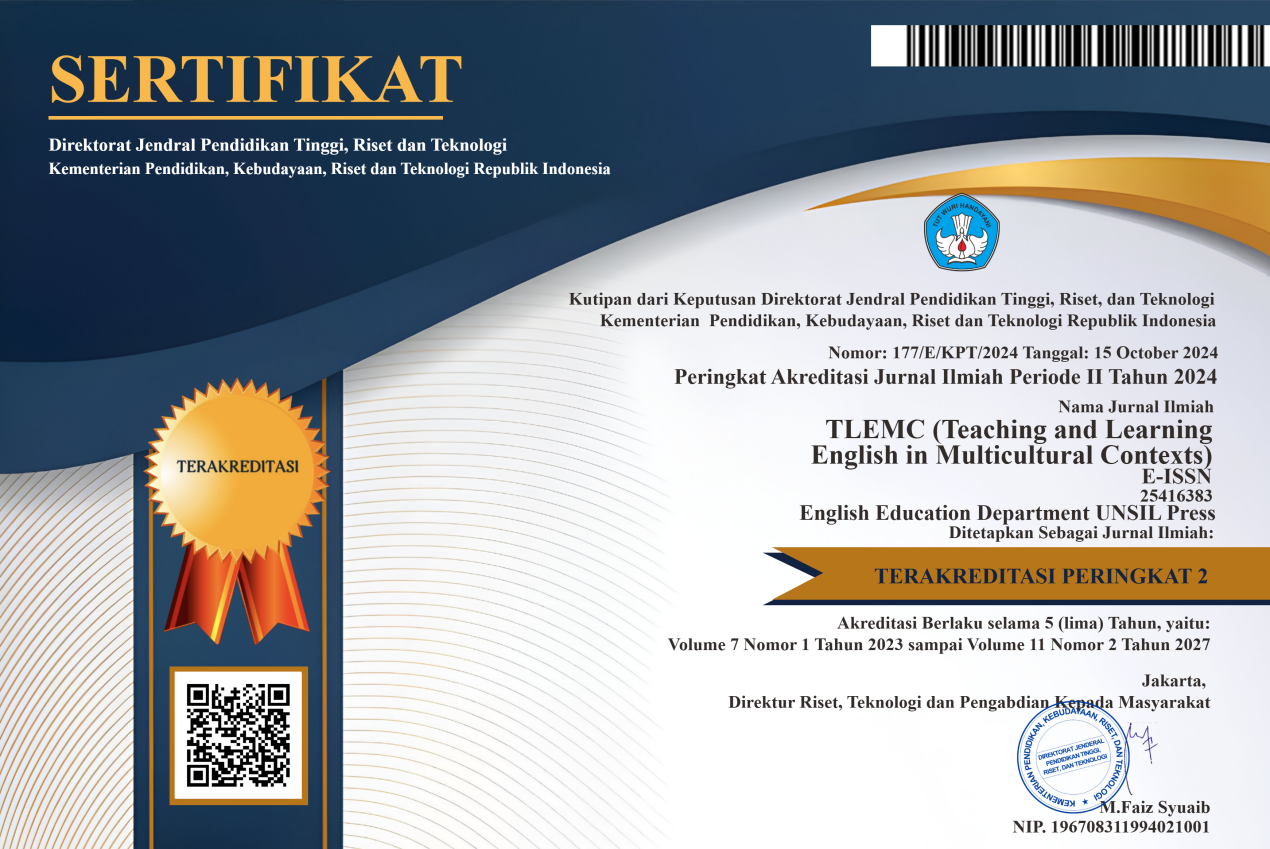Motivating Students to Learn English Speaking through Collaborative Activities
Abstract
Motivation plays an indispensable role in the students' English language learning. As a result, teachers are expected to be able to employ miscellaneous teaching activities to enhance the students' motivation. One of them is collaborative teaching activities. In particular, collaborative teaching activities should not only engage students to learn enthusiastically but also help teachers organize and prepare their teaching practices flexibly. The present study accentuated to delineate students’ motivation on the implementation of collaborative teaching activities during learning English speaking. The participants were ten students of a university in Banjarmasin, Indonesia. The data were gathered through administering an open-ended questionnaire and analyzed with Thematic Analysis (TA) (Braun & Clarke, 2006). The findings reported that students were motivated to learn English speaking through collaborative activities.
Full Text:
PDFReferences
Abdullah, F., Tandiana, S. T., & Amelia, R. (2020). Storybird-Based Narrative Writing Activities among Indonesian EFL Learners: Focusing on Contributions. Premise: Journal of English Education and Applied Linguistics, 9(2), 164-182.
Andriani, A., & Abdullah, F. (2017). Invigorating the EFL students in acquiring new linguistic knowledge: Language learning through projects. Proceedings of the 4th international language and language teaching conference, Nov 2017, (pp. 1-15). Yogyakarta: English Language Education Study Program, Sanata Dharma University.
Braun, V., & Clarke, V. (2006). Using thematic analysis in psychology. Qualitative Research in Psychology, 3, 77–101.
Brown, H. (1987). Principles of language learning and teaching. Englewood Cliffs, N.J. Prentice-Hall.
Celce-Murcia, M. and Olshtain, E. (2000). Discourse and Context in Language Teaching: A Guide for Language Teachers. Cambridge: Cambridge University.
Creswell, J. W. (2014). Research Design: Qualitative, Quantitative, and Mixed Methods Approaches. Thousand Oaks, CA: Sage Publications, Inc.
Csizér, K., & Dörnyei, Z. (2005). The internal structure of language learning motivation and its relationship with language choice and learning effort. The modern language journal, 89(1), 19-36.
Darvin, R., & Norton, B. (2021). Investment and motivation in language learning: What's the difference?. Language Teaching, 1-12.
Dewi, R. S., Kultsum, U., & Armadi, A. (2016). Using Communicative Games in Improving Students’ Speaking Skills. English Language Teaching, 10(1), 63. https://doi.org/10.5539/elt.v10n1p63
Dörnyei, Z. (1994). Motivation and motivating in the foreign language classroom. The modern language journal, 78(3), 273-284.
Dörnyei, Z. (2001). Motivational Strategies in the Language Classroom. Cambridge University Press. ISBN ISBN-13 978-0-511-50056-5.
Dörnyei, Z., & Clément, R. (2001). Motivational Characteristics of Learning Different Target Languages: Results of a Nationwide Survey. Motivation and Second Language Acquisition (Technical Report #23), 2001, 399–432.
Farooq, M. U. (2015). Creating a communicative language teaching environment for improving students’ communicative competence at EFL/EAP University level. International Education Studies, 8(4), 179–191. https://doi.org/10.5539/ies.v8n4p179
Gardner, R.C. (1992). “Second Language Learning,†In Applied Language Learning, vol.2, pp. 1-28.
Hauserman, C. (1992). Seeking an effective collaborative learning strategy. Contemporary Education.
Horwitz, E & Young, D.J. (1990). Language Anxiety. English Cliffs, NJ: Prentice-Hall regents.
Hymes, D. H. (1972). On communicative competence. In J. B. Pride, & J. Holmes (Eds.), Sociolinguistics: Selected readings (pp. 269-93). Harmondsworth, UK: Penguin
Jenkins, J. (2007). English as a lingua franca: Attitude and identity. Oxford: Oxford University Press.
Lasagabaster, D. (2017). Language learning motivation and language attitudes in multilingual Spain from an international perspective. The Modern Language Journal, 101(3), 583-596.
Mistar, J. (2005). Teaching English as a foreign language (TEFL) in Indonesia. Teaching English to the world: History, curriculum, and practice, 71-80.
Musthafa, B. (2010). Teaching English to young learners in Indonesia: Essential requirements. Educationist Journal, 4(2), 120-125.
Namaziandost, E., Shatalebi, V., & Nasri, M. (2019). The impact of cooperative learning on developing speaking ability and motivation toward learning English. Journal of Language and Education, 5(3), 83–101. https://doi.org/10.17323/jle.2019.9809
Naranjo, J. (2014). A Case Study On Collaborative Group Activities To Reduce Efl Learners’ Foreign Langauge Speaking Anxiety In A University Context. In Applied Microbiology and Biotechnology (Vol. 85, Issue 1). https://doi.org/10.1016/j.bbapap.2013.06.007
Nufus, T. Z. (2021). Teaching English to Young Learners in Indonesia (Pros and Cons). English Language in Focus (ELIF), 1(1), 65-70.
Nunan, D. (2000). Language Teaching Methodology: A textbook for teachers. New York: Prentice-Hall, Inc.
Oga-Baldwin, W. Q., & Fryer, L. K. (2020). Profiles of language learning motivation: Are new and own languages different?. Learning and Individual Differences, 79, 101852.
Ohno, A. (2006). Communicative Competence and Language Teaching. In Western European Education (Vol. 14, Issue 3, pp. 115–119). https://doi.org/10.2753/eue1056-49341403115
Papi, M., & Hiver, P. (2020). Language learning motivation as a complex dynamic system: A global perspective of truth, control, and value. The Modern Language Journal, 104(1), 209-232.
Rooks, George. (1981). The Non-Stop Discussion Workbook. Newbury House Publisher Massachusetts, USA.
Sapon-Shevin, M & Schniedewind, N. (1993). Why (even) gifted children need collaborative learning. Educational Leadership.
Scarcella, R.C., and Oxford, R.L., (1992). The Tapestry of English Learning: The individual in the Communicative Classroom. Boston, M: Heinle & Heinle Publishers.
Schiller, E., & Dorner, H. (2021). Factors influencing senior learners’ language learning motivation. A Hungarian perspective. Journal of Adult Learning, Knowledge and Innovation.
Silalahi, R M. (2021). Nativespeakerism and world Englishes Teachers perception towards non-native English varieties. Journal of English language and culture, 11(2).
Sulistiyo, U., Haryanto, E., Widodo, H. P., & Elyas, T. (2020). The portrait of primary school English in Indonesia: policy recommendations. Education 3-13, 48(8), 945-959.
Taguchi, N., & Ishihara, N. (2018). The pragmatics of English as a lingua franca: Research and pedagogy in the era of globalization. Annual Review of Applied Linguistics, 38, 80-101.
Tavil, Z. M. (2010). Integrating listening and speaking skills to facilitate English language learner’s communicative competence. Procedia - Social and Behavioral Sciences, 9, 765–770. https://doi.org/10.1016/j.sbspro.2010.12.231
Thompson, A. S. (2017). Language learning motivation in the United States: An examination of language choice and multilingualism. The Modern Language Journal, 101(3), 483-500.
Ushers, R. (1986). “A Critique of Neglected Epistemological Assumptions of Educational Research." In D. Scott and R. Usher (Eds.). Understanding Research. London: Routledge.
Vránová, M. (2020). Modern Media and Social Networks in ELT as Source of Motivation. Univerzita Hradec Králové Pedagogická fakulta
Wahyuningsih, S., & Afandi, M. (2020). Investigating English Speaking Problems: Implications for Speaking Curriculum Development in Indonesia. European Journal of Educational Research, 9(3), 967-977.
Wang, X., Jiang, L., Fang, F., & Elyas, T. (2021). Toward critical intercultural literacy enhancement of university students in China from the perspective of English as a lingua franca. Sage Open, 11(2), 21582440211027544.
Wehner, A. K., Gump, A. W., & Downey, S. (2011). The effects of Second Life on the motivation of undergraduate students learning a foreign language. Computer Assisted Language Learning, 24(3), 277–289. https://doi.org/10.1080/09588221.2010.551757
DOI: https://doi.org/10.37058/tlemc.v5i1.2059
Refbacks
- There are currently no refbacks.
INDEXED BY:
This work is licensed under a Creative Commons Attribution-NonCommercial-ShareAlike 4.0 International License.
![]()
TLEMC (Teaching and Learning English in Multicultural Contexts)
Program Studi Pendidikan Bahasa Inggris
Fakultas Keguruan dan Ilmu Pendidikan
Universitas Siliwangi
Jl. Siliwangi No. 24 Kota Tasikmalaya - 46115
email: tlemc@unsil.ac.id





